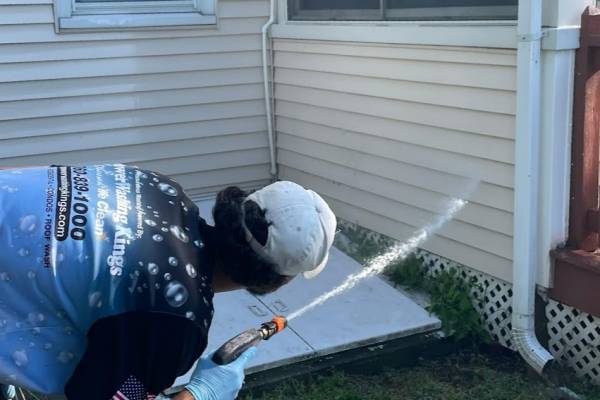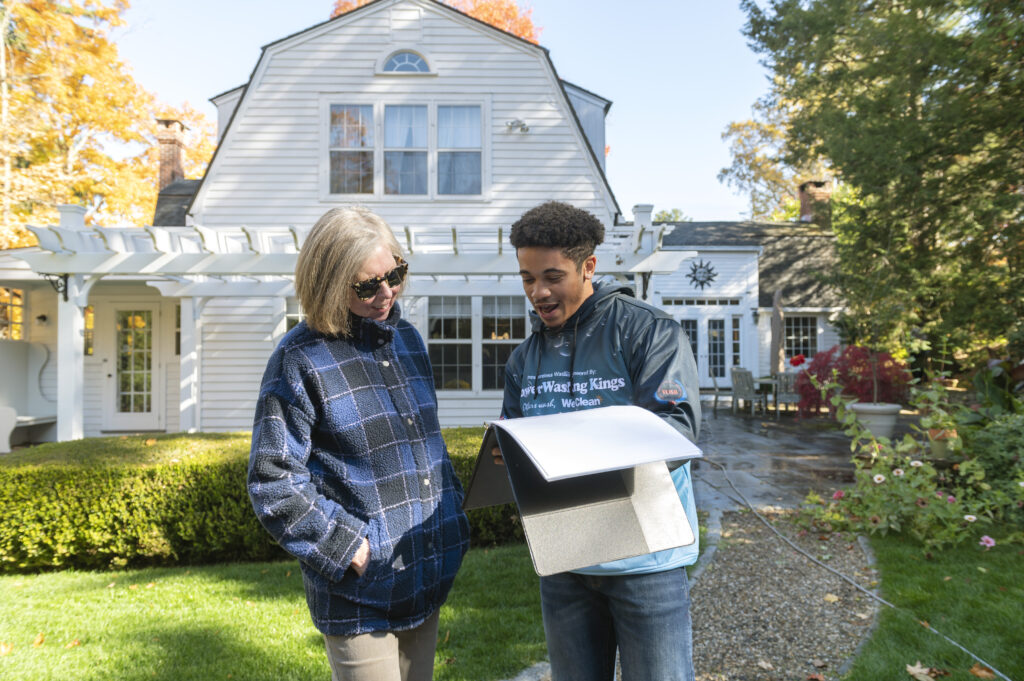Unveiling the Best Practices for Pressure Washing
Do you ever wonder what the real secret is behind getting flawless results when pressure washing a surface? The answer lies in understanding the best practices for using a pressure washer. Whether you’re tackling mold-ridden siding, sticky grime on concrete tanks or anything else that needs power-washing, knowing how to do it correctly will save time and money while delivering outstanding cleans. In this blog post, we’ll give you an insider’s view of how to use a power washer so your surfaces are spotless after every wash. So read on to learn more about our tested techniques and advice!
Overview of Pressure Washing & Benefits
Pressure washing or power washing is a cleaning method that uses a high-pressure water spray to remove stubborn dirt, grime, mold, and stains from various surfaces. It’s commonly used on buildings, concrete surfaces, vehicles, and outdoor furniture. The technique is highly effective in restoring surfaces to their original condition, often making them look brand new.

Benefits of pressure washing extend beyond mere aesthetics. Regular power washing can help maintain the value of your property and prevent the deterioration of surfaces. It can eliminate potentially harmful substances like mold, mildew, and algae, creating a healthier environment. Moreover, it is a time-efficient cleaning method, allowing large areas to be cleaned rapidly compared to traditional methods. Overall, pressure washing is an integral part of property maintenance that combines efficiency, health, and aesthetic benefits.
Preparing the Area for Pressure Washing
Before you start pressure washing, it’s crucial to prepare the area properly to avoid damage and ensure efficient cleaning. Begin by removing loose objects from the area you intend to clean. This includes outdoor furniture, plant pots, toys, or any moveable decorative items. These objects can become potential projectiles under high pressure, posing a safety risk.
Next, protect delicate areas such as windows, glass doors, or light fixtures that could be damaged by the high pressure. You can cover these areas with a waterproof cover or tape.
Also, ensure that all doors and windows are completely closed to prevent water from seeping inside your property. If you’re washing walls with electrical fixtures, make sure to turn off power to these areas to avoid electrical accidents.
Lastly, sweep away any loose debris from the surface before you begin washing. This step allows the pressure washer to work more efficiently in removing stubborn dirt and grime.
Remember, proper preparation sets the stage for a successful pressure washing task.
Selecting the Right Pressure Washer Nozzle
Understanding the importance of selecting the right nozzle for a pressure washer is critical in achieving optimal cleaning results. Nozzles come in different shapes and sizes, each designed to deliver a particular pressure and spray pattern, suitable for different cleaning tasks.
Most pressure washers come with a set of interchangeable nozzles, typically color-coded to indicate their spray patterns and pressure levels. For instance, a red nozzle delivers a narrow, high-pressure spray suitable for tackling stubborn grime on concrete. A green nozzle provides a slightly wider spray, ideal for washing cars or boats without causing damage. The white nozzle offers an even broader spray, suitable for cleaning siding or deck surfaces. Lastly, the black nozzle sprays water at a low pressure, perfect for applying cleaning detergents.
Always start with the nozzle that delivers the least pressure, and progress to a higher-pressure nozzle if necessary. Remember, an overly aggressive nozzle can damage the surface you’re trying to clean, so approach with caution. Selecting the right nozzle will ensure effective and safe cleaning, enhancing the longevity and appearance of your surfaces.
Determining the Strength of Your Cleaning Solution
Determining the strength of your cleaning solution is an essential step in the pressure washing process. The type and degree of dirt, grime, or stain on the surface will dictate the strength needed for your cleaning solution. For relatively clean surfaces with light dust or dirt, a mild solution or even plain water may suffice. Tougher stains like oil, grease, or mold might require a more potent solution or a specific cleaning agent designed to combat those substances.
Ensure to follow the manufacturer’s instructions when mixing your cleaning solution, as a too strong mix can potentially damage your surfaces. Additionally, consider the environmental impact of your cleaning solution. Opt for biodegradable and non-toxic cleaners when possible to reduce harm to plants and animals around your cleaning area. Remember, an effective cleaning solution, when used correctly, can enhance the efficiency of your pressure washing and result in a truly spotless surface.
Tips & Tricks to Help You Get Professional Results Every Time
Start From the Top: When pressure washing, always start from the top of the surface and work your way down. This technique allows the dirt to flow downwards, avoiding streaks and making the cleaning process more efficient.
Use a Sweeping Motion: To avoid zebra striping, use a consistent sweeping motion. This method helps distribute the water pressure evenly across the surface.
Don’t Get Too Close: Aim to keep a safe distance between the nozzle and the surface. Being too close can potentially cause damage, especially to softer materials. A distance of about six to twelve inches is generally safe.
Avoid Pressure Washing Under High Heat: Pressure washing under high heat can cause the water to evaporate too quickly, leaving behind streaks of detergent and dirt. It’s best to pressure wash on cooler, overcast days.
Rinse Thoroughly: After applying detergent, ensure you rinse thoroughly. Residual detergent can attract dirt and may cause harm to the surface over time.
Regular Maintenance: Regularly maintaining your pressure washer ensures its longevity and performance. This includes checking the fuel, oil, and air filters, as well as inspecting the spray gun, hoses, and nozzles for any damage.
Remember, mastering these tips and tricks can help you achieve professional results every time you pressure wash, saving you time and money while preserving the beauty of your property.
How Often Should You Pressure Wash Surfaces for Maximum Cleanliness
The frequency of pressure washing varies depending on the type of surface and its exposure to dirt, weather elements, and foot or vehicle traffic. As a general guideline, residential properties benefit from a thorough pressure washing once a year. However, heavily trafficked areas such as driveways or patios might require more frequent cleaning, perhaps twice a year. Commercial properties or public spaces often require pressure washing on a more regular basis, potentially quarterly, due to higher usage and to maintain a clean and welcoming appearance. Always consider the material and condition of the surface before pressure washing to prevent unnecessary wear or damage. Remember, regular pressure washing not only maintains cleanliness but also contributes to the long-term preservation of your property.

Common Mistakes to Avoid When Using a Power Washer
While power washing can be incredibly effective, it’s essential to avoid common mistakes to prevent damage and ensure optimal results.
- Using Too Much Pressure: High pressure is not always better. Using excessive power can damage surfaces, especially softer ones like wood or vinyl siding. Always start with the lowest pressure and increase as necessary.
- Neglecting Safety Measure: Power washers can cause severe injuries if not handled properly. Always wear protective gear, including gloves and eye protection, and never point the washer at people or pets.
- Forgetting to Prep the Area: Failing to prepare the area can result in debris flying around, potentially causing injury or damage. Always clear the area and cover anything you don’t want to get wet.
- Using the Wrong Cleaning Solutions: Not all cleaning solutions work for every job. Using the wrong one can leave behind residues or damage the surface you’re cleaning. Always choose a cleaning agent suitable for your specific task and surface.
- Ignoring the Manufacturer’s Instructions: Each power washer is different. Ignoring the manufacturer’s instructions can lead to improper use and potential damage. Always refer to the user manual for guidance on operations and safety precautions.
Avoiding these common mistakes can ensure your power washing tasks are safe, effective, and efficient.
In conclusion, pressure washing is a powerful and effective method for cleaning various surfaces. To achieve professional results, carefully choose the right nozzle and determine the strength of your cleaning solution. Follow tips and tricks to ensure safe and efficient cleaning, as well as proper maintenance of your pressure washer. Remember to consider the frequency of pressure washing depending on the surface type and conditions. Most importantly, avoid common mistakes to prevent damage and maximize the benefits of power washing. By following these guidelines, you can effectively clean and maintain the beauty of your property with ease.
https://www.google.com/maps?cid=15281146218207190632


